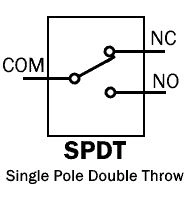OUTLINE:
Electrical Switch Symbols: Decoding Common Switch Symbols
 559
559Electrical switch symbols are a vital part of the language used in electrical schematics and diagrams. These symbols help electricians and engineers understand how electrical components are connected and functioning within a circuit.
What Are Electrical Switch Symbols
Electrical switch symbols are a standardized way to represent different types of switches in electrical schematics and diagrams.
Here's a breakdown of some common electrical switch symbols:
Basic Toggle Switch:
-
Represents a simple on/off switch with two positions.
-
One position completes the circuit (allowing current flow), and the other position breaks the circuit (stopping current flow).
-
Shown as a straight line with a vertical line bisecting it at one end, indicating the two switch positions.

Single-Pole, Single-Throw (SPST) Switch:
-
A specific type of toggle switch with one input and one output.
-
The switch controls the connection between a single input and a single output.
-
Represented by a horizontal line with a vertical line intersecting it near one end, similar to a basic toggle switch but without the bisecting line.
Single-Pole, Double-Throw (SPDT) Switch:
-
Another type of toggle switch with one input and two outputs.
-
The switch can connect the input to either of the two outputs.
-
Shown as a horizontal line with a short line branching out on either side, and a diagonal line through the main line indicating the movable contact.

Push Button Switch:
-
Represents a switch that requires pressing to activate and releases when pressure is lifted (maintained position).
-
Often used for momentary switching functions.
-
Symbolized by a circle with a vertical line inside it.
Normally Open (NO) and Normally Closed (NC) Contacts:
-
These symbols are often used in conjunction with other switch symbols to indicate the default state of the switch contacts.
-
Normally Open (NO): The contacts are separated when the switch is not activated (open circuit).
-
Normally Closed (NC): The contacts are touching when the switch is not activated (closed circuit).
-
Represented by the letters "NO" or "NC" placed near the switch symbol.
The Usages Of Electrical Switch Symbols
Electrical switch symbols provide a standardized way to represent different types of switches, allowing electricians, engineers, and anyone working with circuits to understand how electrical components are connected and function.
1. Simplifying Complex Circuits:
Electrical circuits can involve numerous components and connections. Using symbols instead of detailed drawings of each switch simplifies the schematics, making them easier to read and interpret. Imagine a complex lighting system with multiple toggle switches and dimmer controls. Representing them with symbols creates a clearer picture of the overall functionality compared to trying to depict every physical detail.
2. Universal Communication:
Electrical switch symbols are standardized across different countries and regions. This ensures everyone working with the schematics understands the functionality of the switches regardless of language barriers. An electrician in France can interpret a schematic created in Japan using the same switch symbols, facilitating collaboration and knowledge sharing.
3. Functionality at a Glance:
Switch symbols convey the essential function of a switch within the circuit. By looking at the symbol, you can understand whether it's a simple on/off switch, a switch that can connect to one of two outputs, or a momentary push button. This quick visual understanding allows for faster troubleshooting and circuit analysis.
4. Promoting Accuracy and Efficiency:
Using standardized symbols minimizes the risk of misinterpretations in circuit designs. This accuracy is crucial for ensuring the safety and proper functioning of electrical systems. Additionally, electrical schematics with clear switch symbols allow for efficient troubleshooting and maintenance. Technicians can quickly locate and identify switch-related issues within the circuit.
Conclusion
In conclusion, electrical switch symbols are a cornerstone of effective electrical communication.They simplify complex circuits, promote universal understanding, and ensure accurate representation of switch functionalities. By understanding these symbols, you gain valuable insight into how electrical circuits are designed and controlled.

Disclaimer: The views and opinions expressed by individual authors or forum participants on this website do not represent the views and opinions of Chipsmall, nor do they represent Chipsmall's official policy.

share this blog to:

